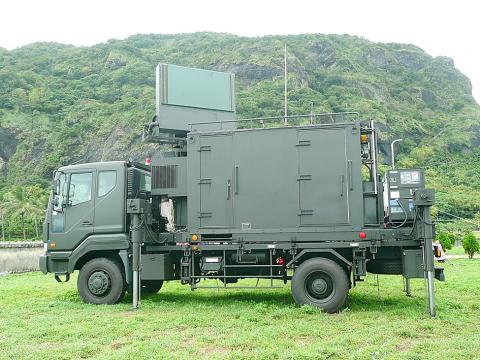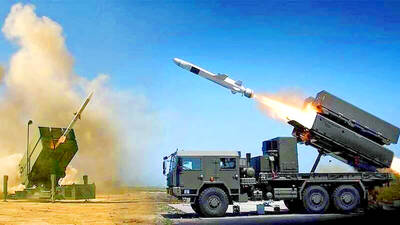As the Chinese People’s Liberation Army Air Force (PLAAF) deploys J-20 stealth fighters in increasing numbers, Taiwan is fielding mobile passive radar systems to defend its airspace against stealth aircraft, a senior Ministry of National Defense official said.
Two radar units — developed by the ministry-affiliated Chungshan Institute of Science and Technology — would be deployed some time this year for operational testing, the officials said on condition of anonymity.
The system would enter mass production in 2020 if the military decides that it meets its operational needs, he said.

Photo copied from the Chungshan Institute of Science and Technology’s Web site
The institute has been working for years to incorporate Western military technological trends in its mobile passive radar system, the official added.
The military’s concept for counter-stealth air defense is comprised of active and passive systems, which would detect, track and lock on to stealth targets at long range, the official said.
The active means would consist of upgraded F-16 warplanes, which have advanced radar systems capable of detecting stealth aircraft, he said, referring to F-16V aircraft and the APG-83 Scalable Agile Beam Radar.
The radar systems would comprise the passive end of the system, the official said.
The mobile units will be remotely linked to active phased array radar systems and “magnify” the radar cross-section of detected objects without emitting radiation, he said.
They are less vulnerable to electronic warfare interference and anti-radiation missile attacks, a fact sheet published by the institute said.
China claims that the J-20, its indigenous stealth strike fighter, performs on a par with the US’ F-22 Raptor, the official said, adding that the jet is likely capable of attacking targets at sea.
The radar systems are a response to the threat posed by Chinese stealth fighters, including its modified Su-35 fighters, which the PLAAF has been coating with radiation-absorbing paint to give them a measure of stealth, he said.
While the J-20 is in limited service, there is no doubt that the PLAAF will increase the size of its stealth fighter fleet and supplement it with other warplanes, which would pose a significant threat to Taiwan’s air defense, he said.
“These developments will erode the detection range of our advanced warning radar systems or even lead to the complete loss of advanced warning and quick reaction capabilities,” he said. “The military must plan for and deploy countermeasures to preempt them.”
The PLAAF on Friday last week dispatched formations of Su-35 fighters and H-6K bombers to fly around Taiwan, the first time that the former was sent on such a patrol.
The Chinese military claims that the J-20 has been deployed in air combat drills at sea.

AIR DEFENSE: The Norwegian missile system has proved highly effective in Ukraine in its war against Russia, and the US has recommended it for Taiwan, an expert said The Norwegian Advanced Surface-to-Air Missile Systems (NASAMS) Taiwan ordered from the US would be installed in strategically important positions in Taipei and New Taipei City to guard the region, the Ministry of National Defense said in statement yesterday. The air defense system would be deployed in Taipei’s Songshan District (松山) and New Taipei City’s Tamsui District (淡水), the ministry said, adding that the systems could be delivered as soon as the end of this year. The US Defense Security Cooperation Agency has previously said that three NASAMS would be sold to Taiwan. The weapons are part of the 17th US arms sale to

SERIOUS ALLEGATIONS: The suspects formed spy networks and paramilitary groups to kill government officials during a possible Chinese invasion, prosecutors said Prosecutors have indicted seven retired military officers, members of the Rehabilitation Alliance Party, for allegedly obtaining funds from China, and forming paramilitary groups and assassination squads in Taiwan to collaborate with Chinese troops in a possible war. The suspects contravened the National Security Act (國家安全法) by taking photos and drawing maps of key radar stations, missile installations and the American Institute in Taiwan’s headquarters in Taipei, prosecutors said. They allegedly prepared to collaborate with China during a possible invasion of Taiwan, prosecutors said. Retired military officer Chu Hung-i (屈宏義), 62, a Republic of China Army Academy graduate, went to China

INSURRECTION: The NSB said it found evidence the CCP was seeking snipers in Taiwan to target members of the military and foreign organizations in the event of an invasion The number of Chinese spies prosecuted in Taiwan has grown threefold over a four-year period, the National Security Bureau (NSB) said in a report released yesterday. In 2021 and 2022, 16 and 10 spies were prosecuted respectively, but that number grew to 64 last year, it said, adding that the Chinese Communist Party (CCP) was working with gangs in Taiwan to develop a network of armed spies. Spies in Taiwan have on behalf of the CCP used a variety of channels and methods to infiltrate all sectors of the country, and recruited Taiwanese to cooperate in developing organizations and obtaining sensitive information

BREAKTHROUGH: The US is making chips on par in yield and quality with Taiwan, despite people saying that it could not happen, the official said Taiwan Semiconductor Manufacturing Co (TSMC, 台積電) has begun producing advanced 4-nanometer (nm) chips for US customers in Arizona, US Secretary of Commerce Gina Raimondo said, a milestone in the semiconductor efforts of the administration of US President Joe Biden. In November last year, the commerce department finalized a US$6.6 billion grant to TSMC’s US unit for semiconductor production in Phoenix, Arizona. “For the first time ever in our country’s history, we are making leading edge 4-nanometer chips on American soil, American workers — on par in yield and quality with Taiwan,” Raimondo said, adding that production had begun in recent